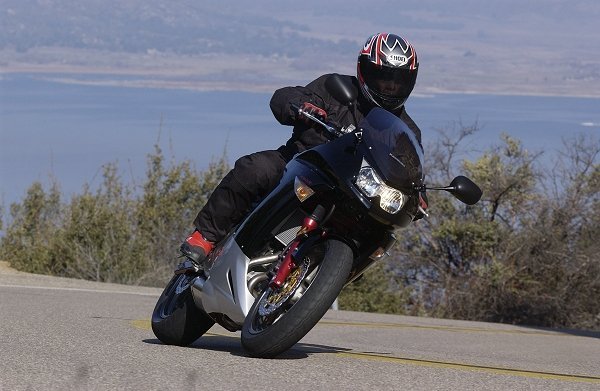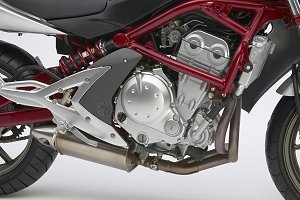2006 Kawasaki Ninja 650 Specs

When Kawasaki decided to create what we might call a "budget middleweight" to compete with bikes like Suzuki's SV650, the company started with a clean sheet of paper and directed its designers and engineers to implement innovative concepts to help achieve their goals for the machine. These goals dictated a bike that was extremely rider-friendly, particularly for new riders, while still being fun for the more experienced customer. In addition, Kawasaki wanted a lightweight (for the class) machine with a low seat height, narrow overall width, a confidence-inspiring riding position, and of course good looks. What they come up with is the new Ninja 650R.
The Ninja 650R's engine is an all new, liquid-cooled parallel twin powerplant that was designed to be extremely compact and lightweight. In fact, the 649cc DOHC 4-valve per cylinder engine is even smaller and lighter than the parallel twin used in the Ninja 500! Kawasaki accomplished this by using a triangular layout of the crankshaft and transmission shafts to reduce front-to-back length, using a semi-dry sump system to reduce height, and using internal design features like plated, liner-less cylinders to reduce engine width.
The 650R powerplant was tuned for smooth, rider-friendly low-end and midrange power, and dual throttle valves in the 38mm Keihin throttle bodies help to provide smooth response and precise roll-on power. The motor was also designed to meet stringent Euro 3 emissions standards, which are even stricter than those in California.
The six-speed transmission is designed as a cassette-style unit, with the input and output shafts and shift drum contained in a compact package that can be removed as one unit for easy transmission maintenance.

This powerplant rides in a narrow, minimalist steel frame. The extremely compact engine allows the use of a longer swingarm for better handling and more precise suspension action, while still maintaining a short overall wheelbase for maneuverability. Kawasaki engineers used computer analysis to help design a frame with an ideal balance of stiffness and flex, which these days seems to be an accepted necessity for creating a machine with good handling characteristics.
The most noticeable result of Kawasaki's push for compact design is the offset, laydown rear shock, which is actuated directly by the swingarm rather than through a progressive linkage. This offset layout allowed engineers to place the bike's battery next to the shock rather than beneath or in front of it as would have otherwise been necessary – helping to maintain the bike's overall compact nature and contributing to the low seat height.
The 650R rolls on lightweight 6-spoke wheels similar to those found on the ZX-6R and ZX-10R, and features "petal" shaped brake discs (dual 300mm in front and single 220mm out back), also similar to those found on Kawasaki's sport bikes. These discs are gripped by dual 4-piston Tokico calipers in the front and a twin-piston Tokico caliper in the rear.

We had a chance to spend a day, and roughly 140 miles, aboard the 2006 Ninja 650R here in Southern California recently. We rode the 650R on freeways, tight, twisty mountain roads, and everything in between. For a single day of riding, it was a pretty thorough test.
The first thing we noticed about the 650R was the engine performance. When Kawasaki told us this was a thoroughly modern, high performance twin they were not kidding. The motor is very smooth, and the power comes on without any surprises, but it is more than ample. We did not get a chance to test it against a Suzuki SV650 (which would have to be considered the standard in this class), but the power characteristics, and the peak power appears to be on par with the outstanding v-twin found in the Suzuki. The mid-range, in particular, is very strong.
The engine is also very flexible. It can be lugged down to 2,500 rpm or so in a taller gear without feeling like it is ready to stall, but it is happiest between 4,000 and 9,000 rpm. Above 9,000 rpm, it will continue to rev and pull, but the power flattens out a bit. Nevertheless, the 650R has a very broad, very usable spread of power.
The 650R will reach an indicated 120 miles per hour without too much trouble, but it doesn't have much top speed left at that point.
The engine really sounds great while you are riding, as well. Like many v-twins, the induction noise as air is fed to this parallel twin a short distance below your ears is real music. Particularly, as you hit the meat of the mid-range above 6,000 rpm, the 650R simply sounds fantastic to the rider. This was a big part of the enjoyment offered by the bike during our test, and should not be discounted as an important aspect of the ownership experience.

Just as the engine impressed us, the handling was hard to fault. This bike has a very solid, neutral feeling that inspires confidence as soon as you pull away from a stop for the first time. The comfortable seating position and the smooth engine acceleration certainly contributed, but there is something about the chassis of this bike that makes you want to climb aboard and ride aggressively. Ridden hard, the chassis remains composed, stable and yet plenty nimble to toss around in the tight, twisty stuff. Although the steering geometry feels fairly relaxed (contributing to the stability of the bike), the lightweight, narrow chassis and relatively low center of gravity allow you to take the wide, dirt bike-style handlebars and really toss this bike from side to side.
Adding one click of spring preload to the shock (from position two to position three) helped this 215 pound tester feel even more confident on the machine by shifting a bit more weight to the front end of the bike.
The budget nature of the bike does come through in some areas, but not in any manner that spoils the overall experience of the 650R. The non-adjustable forks did not soak up choppy road surfaces as well as they might have, while the preload adjustable rear shock seemed just about right with the non-adjustable factory valving and spring rate.
Braking power was very good, but modulation of the front brake could have been better. Front brake power came on in a non-linear fashion — with initial brake lever travel resulting in little power followed by a rather sudden increase in braking power. This was not a significant problem, but it was something I needed to get used to during the ride.
After riding cruisers lately, both the clutch lever and the brake lever felt a bit narrow when I grabbed them with my rather large paws. After some time in the saddle, this sensation went away, however.

This bike does have an extremely low seat height, and taller riders may feel a bit cramped. At 5'10", with a 31 inch inseam, I felt right at home in the saddle of the 650R. I also welcomed the short reach to the upright bars, and the generous wind protection offered by the full fairing. Seat comfort wasn't bad either, and certainly better than some of the seats found on modern sport bikes. We did not test passenger accommodations.
The analog tach and speedometer were easy enough to read, and overall instrumentation was adequate even if lacking some of the features found on more expensive models (such as a progressive fuel gauge).
We had no issues with either the clutch of the transmission during our ride — both doing their job admirably. The six-speed transmission seems to have ratios that match up well with the bikes' engine performance.

At a U.S. MSRP of $6,299, this is an awful lot of motorcycle. Modern styling, a thoroughly modern fuel injected motor, comfortable, upright ergonomics and full wind protection are very hard to argue with. The constant grin I had on my face while riding this spunky, fun machine is impossible to argue with. If the 2006 Ninja 650R is what "budget" bikes have come to, we have certainly come a long way. This is a fun, practical machine that is not likely to disappoint any rider (male or female) of any skill level.
The 2006 Ninja 650R is available in two color schemes, silver and black, and should be arriving at U.S. dealers now. For additional details and specifications, visit Kawasaki's web site here.
You can follow any responses to this entry through the RSS 2.0 feed. Both comments and pings are currently closed.
Source: https://www.motorcycledaily.com/2005/12/22december05_ninja650/








Tidak ada komentar:
Posting Komentar